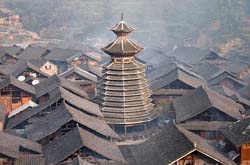
Drum towers are a specialty and symbol of the Dong nationality. They first appeared in villages along the Yellow River during the Northern Dynasties (386-581 A.D). the oldest standing drum towers date from the Shunzhi period (1644-1661 A.D) of the Qing Dynasty.
A typical large village consists of from 500 to 600 families, and a small one, of about 50 families. As a rule, one village is said to contain families of one or two surnames. Each drum tower signifies one surname; some villages have two or three drum towers, therefore indicating that two or three surnames dominate the village.
The outline of a Dong drum tower resembles a fir tree, a sacred tree in Dong culture. Some anthropologists have suggested that the Dong people used to be treedwellers, since they are believed to be a branch of the ancient Yue people, a treedwelling tribe.
Dong people visit neighboring villages during festivals to admire their towers. At such times, the villages sing in praise of the tower's grandeur, pray for rich harvests, and wish their elderly longevity. Next to the elegant lines of the drum tower, they sing, dance and hold "lusheng" competitions.
About 20 meters high, Dong towers are made of fir, and secured with mortises and tenons instead of nails. The upper storeys feature a building technique called "dougong" where brackets are inserted at the intersections of columns and crossbeams. Each bracket consists of a double bow-shaped arm called a "gong" which supports a block of wood called a "dou". The roofs are square, hexagonal or octagonal.
Wood is cut from nearby forests, and is then hand sawn into lumber by the men od the village. As a rule, old trees in and near villages are considered inhabited by protective spirits. Such sacred trees must never be cut down. If this ever occurs, the one responsible must sacrifice an ox, and the wood can then only be used to construct a drum tower. Any remaining wood scrapes must be used as fuel for inside the drum tower, not by an individual in his home.
Believing that the music of the lusheng if played during the rice-planting season leads to poor harvests, the Dong people block the holes of their lushengs and tie them to a pillar of the drum tower during this period.
Dong Villages
Zhaoxing Tang'An Chengyang
Culture of Dongs
Sanyuejie Festival Marriage Customs Music New Year Traditional costumes
Drum Towers Flower Bridges Lusheng Festival
Dong Houses Carrying the Governors Parade
Drama Rice Planting Traditional Common Law Worship the Goddess Sa Sui
|